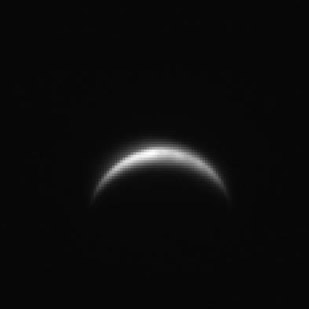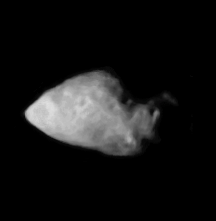Emily Lakdawalla • Jan 14, 2009
Stardust flies by Earth today
In less than two hours, Stardust will approach to within 10,000 kilometers of Earth, getting a gravity assist that will target it for a February 14, 2011 encounter with comet Tempel 1, once the target of the Deep Impact mission. This page from the Stardust-NExT mission (the official name of Stardust's extended mission to Tempel 1) says that just before the flyby, the spacecraft was commanded to take some calibration photos targeting the Moon. There was some concern that during Stardust's original mission, when it flew through the coma of comet Wild-2, the mirrors on its periscope may have gotten pitted by cometary particles, which would have reduced the quality of its camera's images. (Stardust has the periscope to make sure that the camera's optics aren't themselves flying face-on into cometary particles, so that if anything got damaged, it would be the mirrors in the periscope, not the camera itself.) Here are two photos of the Moon taken two days ago, with and without the periscope in the optical path. (The Stardust website did not actually indicate which of these images was taken with the periscope, and which without.)

NASA / JPL
Stardust calibration image of the Moon
These photos of the Moon were captured on January 12, 2009, 55 hours before Stardust approached to 9,200 kilometers of Earth's surface on a gravity assist that would send it on to comet Tempel 1 in February 2011. The photos, taken from a range of 1.1 million kilometers, were part of a test to see whether the periscope had been damaged during Stardust's passage near comet Wild-2 five years previously; one was taken with the periscope in place, the other without. The spacecraft was centered above 127° east longitude for these images, and the lit visible crescent spans from about 37 to 77 east longitude on the Moon including Mares Crisium and Fecunditatis and the bright Crater Stevinus.
NASA / JPL
Stardust's best images of Wild 2
Stardust snapped these six photos of Wild 2 during its closest approach to the small comet on January 2, 2004. It flew within 236 kilometers (147 miles) of Wild 2 at a speed of 6.1 kilometers per second (14,000 miles per hour). These images were taken 44, 24, and 4 seconds before and 16, 36, and 56 seconds after closest approach.
NASA / JPL / Ted Stryk
Asteroid Annefrank
The Stardust spacecraft flew within 3,300 kilometers of asteroid Annefrank on November 2, 2002. Prior to the encounter, little was known about the asteroid except how much light it reflected. It turned out that the brightness of Annefrank had been interpreted incorrectly, leading mission planners to expect a smaller and brighter asteroid. Its size is 6.6 by 5.0 by 3.4 kilometers.The Time is Now.
As a Planetary Defender, you’re part of our mission to decrease the risk of Earth being hit by an asteroid or comet.
Donate Today

 Explore Worlds
Explore Worlds Find Life
Find Life Defend Earth
Defend Earth

